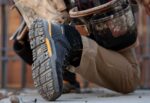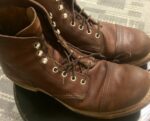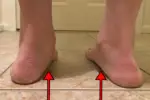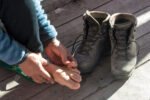Wearing a new pair of shoes can create a series of inconveniences from the need to break them in to avoid blisters to worrying about scuffing them their first day out.
But one of the most embarrassing and annoying consequences of wearing new shoes is when the heels squeak as you walk. To be able to prevent heels from squeaking, your first step should be determining why they squeak.
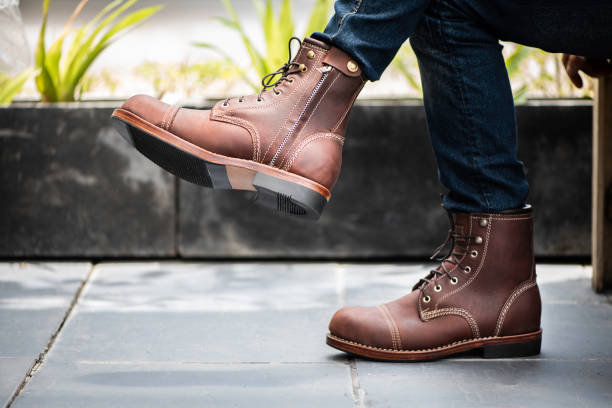
Why Are My Heels Squeaking?
There are a variety of variables that lead to squeaky shoe heels such as the style of a particular shoe, the type of floor or pavement, the age of footwear, or some type of damage present.
Some of the most common causes are new shoes, water damage, new leather shoe insoles, or outsoles made from rubber.
1. A New Pair of Leather Shoes
Often a new pair of leather shoes will squeak because the insoles are rubbing against something within the shoe. If two leather surfaces produce friction of some type, they may squeak, and this is quite common where toe joints are located.
2. Damage from Moisture or Water
Shoe components, even those waterproofed, when soaked can absorb some amount of water. Water within shoe components will cause a squeak during walking especially on hard flooring.
3. Air and Moisture May Be Trapped in the Shoe
Another cause of squeaky shoes is when air and moisture become trapped underneath a loosened insole. The squeak you hear is actually the ejection of air from the space where it is trapped.
When moisture is added to the equation, the squeak will worsen. This is common to the arch area when shoes feature removable footbeds.
4. Rubber Heels
Rubber outsoles will squeak on various types of flooring including tiling, linoleum, and even flooring that has been rubberized. This is because of friction occuring between the rubber sole and the flooring. As you lift your foot, the rubber sole will emit a squeak.
5. Older Shoes with Wear and Tear
Don’t be surprised if one of your older pairs of shoes suddenly begin squeaking. Through daily wear and tear, components will loosen causing some parts of the shoes to rub against each other. This will create a squeak.
Depending on the shoe style, there may be a metal shank in the construction design to support your foot’s arch. As it the shank rubs up against other rubber or leather components, it will cause a squeak in your walk.
Can I Stop My Shoe Heels from Squeaking If I Walk?
There are some DIY methods to remove the squeak from shoes, but you need to initially identify the reason for the squeaking before you can fix it.
Water damage or the wear and tear on an older pair of shoes may be readily identified, but there are other squeaks that may not be so obvious.
When evaluating the reason for the squeak, listen to your shoe and where the squeak seems to originate. If the squeak is due to the shoe construction or worn parts you may be wise to take the footwear to a cobbler or shoe repair center.
If you wish to try and remedy the situation yourself, try one of these DIY solutions to see if one works.
1. Dry Your Shoes Out
This is an obvious solution if your shoes have gotten wet or suffered water damage from a rainstorm of bad weather. Drying will depend on the shoe material, and whether leather, canvas, fabric, or other.
Shoes made of canvas or fabric can be tossed in a dryer without a problem. Place shoes in separate cloth sacks or pillowcases before putting them in the dryer.
Leather shoes should not be exposed to heat sources as they can crack or shrink. The most efficient way to dry them is to stuff them with an old towel or with newspaper and leave them in a relatively warm spot to air dry.
Replace the towels or newspaper once a day if they need more time for drying. Follow up drying with the application of a leather conditioner to protect the shoes.
2. Roughen Shoe Outer Soles
Often with new heels, the rubber used will be squeaky on hard flooring. Use a fine grit sandpaper to roughen new heel surfaces.
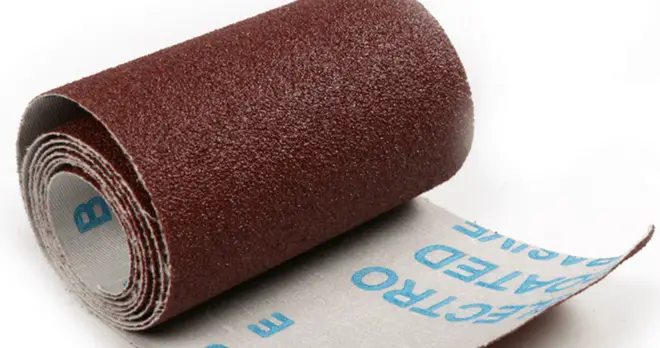
Generally speaking, leather or other harder heel material will not generate a squeak on a hard floor. If, however it happens, use a very fine grit sandpaper on the heel.
In either case, sand lightly and try the heel against the flooring. If it stops squeaking, stop sanding. On rubber outer soles you can also try a rubber spray for soles that affords more grip to eliminate squeaking.
3. Moisturize the Shoes Internally
Sometimes a squeak is due to new parts rubbing together. Apply shoe conditioner or leather balm to the insides of shoes or even Vaseline if you have some at home to stop the squeak.
Use a cotton ball or pad to apply a small amount to the spot where the squeak originates. You may want to attempt to remove insoles before applying a conditioner or jelly. Conditioner or leather balm will penetrate leather better than petroleum jelly.
4. Moisturize the Shoes Externally
Applying a shoe conditioner or leather balm to your shoes will not only keep them in tip top shape but help to reduce squeaks that are emitted from the toe joints and lacing zones.
5. Repair and Worn or Broken Shoe Components
You can glue insoles that slip. Superglue is a great tool, but make sure to keep insoles clamped to the shoe for at least 24 hours before wearing again.
6. Try Talc or Baby Powder
This is a great moisture absorber, so if your squeak is the result of moisture, definitely try this out. Not only will it absorb the moisture trapped in the shoe but will reduce friction among the shoe components.

If your foot beds are removeable, take them out and sprinkle in the talc and joggle the shoe so the powder covers the entire shoe inner. If you are using powder to absorb moisture, wait several hours before wearing again to avoid paste forming.
7. Try Using a Dryer Sheet
This may sound unusual, but by rubbing a rubber sole with a dryer sheet, you are applying a bit of fabric softener to the underside of shoes. Dryer sheets can also be placed inside shoes underneath the footbed to prevent inner components from rubbing against each other.
8. Waterproof Your Shoes
By using a waterproofing spray, you will protect shoes from water and moisture absorption, so components will not become soaked and squeak. Hydrophobic sprays are particularly indicated for fabric, canvas, or suede footwear.
9. Insert Silica Gel
Silica is used to absorb moisture. Consider inserting a silica gel packet inside the shoe when you are not wearing them to absorb any moisture within.
10. Consider Replacing Shoelaces
Sometimes laces can create friction in the eyelet area that in turn makes noise. Try replacing the laces with new ones.
See also: How to Stop your Work Boots from Squeaking?
The Bottom Line
The most important aspect to stopping shoes from squeaking is to identify the cause so you can treat it. If you have doubts or are unsuccessful in your attempts, take the shoes to a cobbler or shoe repair center to end that annoying squeak!



